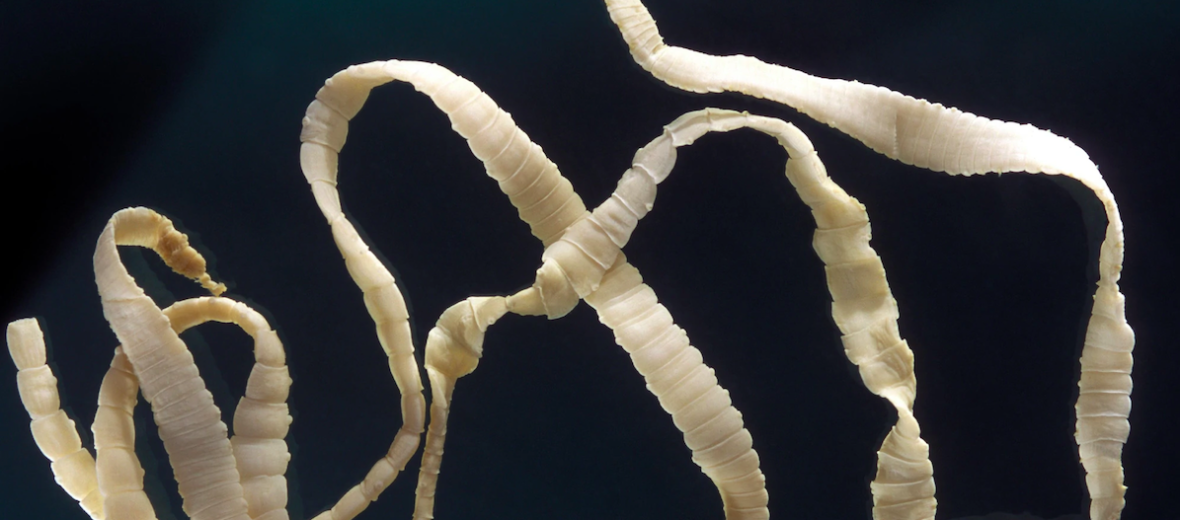
With a world full of parasites, the tapeworm is certainly 1 of the most feared & loathed of them all. Humans and animals can be hosts to tapeworms. These creatures come with a host of falsehoods and misconceptions alike. But one thing is certain, you definitely don’t want to be a host to 1 or more, as problems soon arise. Some are small, but others… well, they’re downright massive! Let’s explore these loathsome creatures and dispel some rumors while we’re at it.
First the Stats…
Scientific name: Cestoda
Length: Up to 100+ feet
Lifespan: Up to 30 years
Now on to the Facts!
1.) These parasites get their name due to their appearance. They are long, flat, and thin. But they are only slightly related to the worms you’re used to seeing.
2.) They gather their nutrition, which was originally your nutrition, by absorbing it via their skin, which is covered with tiny bumps called villi. Just the way your intestines have villi to absorb nutrients.
3.) Tapeworms don’t have a stomach. They just absorb their food, as mentioned above.
4.) Their body is segmented. Each segment is hermaphroditic (possesses both male and female reproductive organs), and can create more tapeworms.
5.) As the parasite grows, new segments are added, just behind the head. The older segments, towards the end, tend to detach (kind of like caudal autonomy, in lizards – where the lizard can break off their tail). These detached segments are filled with eggs, ready to produce more tapeworms.
But wait, there’s more on the tapeworm!
6.) The egg carrying segments either hatch in the original host or are defecated (pooped) out to be ingested by another host.
7.) Living in one’s intestinal tract can be tough, as food and waste are constantly being pushed through and then you add contractions and general movement of the host. With this in play, tapeworms have evolved various grappling techniques to hang on. Some have suction cups on their head, others have retractable hooks, while still others have sharp spines. The attachment method varies from parasite to parasite.
Did you know…?
Not only us humans can get tapeworms. These parasites have been found in a huge variety of critters, from dogs, cats, birds, and fish, to even insects.
8.) How do they get inside our body? Well, the original host consumes tapeworm eggs. Then that host is eaten by another potential host. Then the lifecycle continues, from host to host. A pork tapeworm, for instance, is obtained by eating under-cooked pork. Always properly cook your meats, if you’re a meat eater. Less ye be a host yourself.
9.) Even whales can get infected. 1 was found, in a whale, to be over 100 feet long!
10.) They have been infesting hosts for over 270 million years. So they aren’t going away any time soon.
But wait, there’s still more on the tapeworm!
11.) They can be found on every continent and in every ocean in the world.
12.) They are little manipulators too. 1 type is eaten by a crustacean, that is later consumed by a fish (called a stickleback). Once in the stickleback, the parasite controls the fish’s mind and convinces it to seek out warmer waters. The fish then becomes easy prey for predatory birds. The bird eats the fish and then becomes the parasite’s final destination.
Did you know…?
An infestation can lead to an infection called Cysticercosis – larval cysts infecting brain, muscle, or other tissue, and are a major cause of adult onset seizures in most low-income countries around the world.
13.) A different species infects ants. Then they control the ant and causes it to make itself more of a target for birds. It also causes the ant to turn a yellowish color, possibly to attract the bird.
14.) Many times, a human won’t even know they’re infected. Sans the feeling of nausea or anemia. One sure fire way to tell, as gross as it may seem, is to examine your feces (poop) for segments. Larger specimens leave behind larger segments.
15.) Once an adult or the eggs are ingested, they begin looking for a nice place to set up camp. This could be your intestines, muscle tissue, and even your brain!
But wait, there’s still a little more on the tapeworm!
16.) A common myth is that if you place a bowl of warm milk near an infected person’s mouth, the parasite will exit the person’s mouth and can then be eradicated. False. Warm milk, in a bowl, only does one thing… get cool in the bowl to later be thrown out.
17.) The only thing that can remove an infestation is medicine specifically designed to kill the infection. Not milk.
18.) There are around 5,000 known species of tapeworms. And not all have segments.
Now a Short Tapeworm Video!
Be sure to share & comment below! Also, check out the Critter Science YouTube channel. Videos added frequently!
Want to suggest a critter for me to write about? Let me know here.



